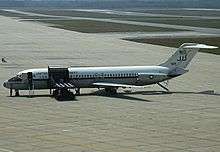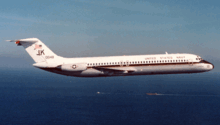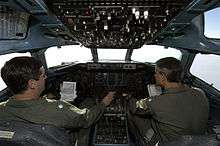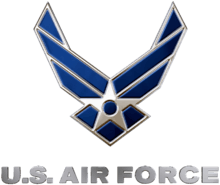McDonnell Douglas C-9
| C-9 Nightingale/Skytrain II | |
|---|---|
 | |
| A C-9A Nightingale used for Aeromedical Evacuation | |
| Role | Jet transport |
| National origin | United States |
| Manufacturer | McDonnell Douglas |
| Introduction | 1968 |
| Retired | September 2005 (USAF C-9A); July 2014 (USN C-9B) |
| Status | In limited service |
| Primary users | United States Air Force (historical) United States Navy (historical) United States Marine Corps Kuwait Air Force |
| Number built | 48 |
| Developed from | McDonnell Douglas DC-9 |
The McDonnell Douglas C-9 is a military version of the McDonnell Douglas DC-9 airliner. It was produced as the C-9A Nightingale for the United States Air Force, and the C-9B Skytrain II for the U.S. Navy and Marine Corps. The final flight of the C-9A Nightingale was in September 2005,[1] and the C-9C was retired in September 2011. The U.S. Navy retired its last C-9B in July 2014.[2] Two C-9Bs remain in service with the U.S. Marine Corps.
Design and development
In 1966, the U.S. Air Force identified a need for an aeromedical transport aircraft and ordered C-9A Nightingale aircraft the following year. Deliveries began in 1968.[3] The U.S. Air Force received 21 C-9A aircraft from 1968 to 1969.[4] The C-9As were used for medical evacuation, passenger transportation, and special missions from 1968 to 2005. The C-9A were named for English social reformer Florence Nightingale (1820–1910), the founder of modern nursing.[5]

After selecting a modified DC-9 for passenger and cargo transport, the U.S. Navy ordered its first five C-9Bs in April 1972.[3] The C-9B aircraft have provided cargo and passenger transportation as well as forward deployed air logistics support for the Navy and Marine Corps. (The original "Skytrain" was the famous C-47 of the World War II era, developed from the civilian DC-3.) A C-9B was also chosen by NASA for reduced gravity research,[6] replacing the aging KC-135 Vomit Comet.
Many of the Navy's C-9Bs have a higher maximum gross take-off weight of 114,000 lb (52,000 kg) and are fitted with auxiliary fuel tanks installed in the lower cargo hold to augment the aircraft's range to nearly 2,600 nautical miles (4,800 km) for overseas missions along with tail mounted infra-red scramblers to counter heat seeking missile threats in hostile environments.

The C-9 fleet was located throughout the continental U.S., Europe, and Asia.[7]
Variants
- C-9A Nightingale - 21 aeromedical evacuation aircraft based on the DC-9-32CF for U.S. Air Force delivered during 1968–69.[4] One was converted for executive transport and stationed at Chievres, Belgium; a second aircraft was converted for VIP transport by the 86th Airlift Wing at Ramstein Air Base.
- C-9B Skytrain II - 24 convertible passenger/transport versions for the U.S. Navy and Marine Corps delivered from 1973 to 1976. An additional five C-9s were converted from passenger configured DC-9s.[8]
- VC-9C - 3 executive transport aircraft for the U.S. Air Force; these delivered in 1976.[8]
- C-9K - 2 aircraft for the Kuwait Air Force.[8]
Operators

%2C_USA_-_Air_Force_AN1673261.jpg)
- C-9A
- 86th Airlift Wing - Ramstein Air Base, Germany 1993-2003
- 75th Airlift Squadron
- 2d Aeromedical Evacuation Squadron 1993-94
- 86th Aeromedical Evacuation Squadron 1994-2003
- 374th Tactical Airlift Wing - Clark Air Base, The Philippines 1974-89
- 20th Operations Squadron 1974-75
- 20th Aeromedical Airlift Squadron 1975-89
- 9th Aeromedical Evacuation Group 1974-75
- 9th Aeromedical Evacuation Squadron 1975-89
- 374th Tactical Airlift Wing/Airlift Wing - Yokota Air Base, Japan 1989-2004
- 20th Aeromedical Airlift Squadron/Airlift Squadron 1989-93
- 30th Airlift Squadron 1993-2004
- 9th Aeromedical Evacuation Squadron 1993-94
- 374th Aeromedical Evacuation Squadron 1994-2004
- 11th Aeromedical Airlift Squadron/Airlift Squadron
- 57th Aeromedical Evacuation Squadron 1973-94
- 375th Aeromedical Evacuation Squadron 1994-2003
- 405th Fighter Wing - Clark Air Base, the Philippines 1972-74
- 20th Operations Squadron
- 9th Aeromedical Evacuation Group
- 10th Aeromedical Evacuation Group
- 435 Tactical Airlift Wing/Airlift Wing - Rhein-Main Air Base, Germany 1975-93
- 55th Aeromedical Airlift Squadron/Airlift Squadron
- 2d Aeromedical Evacuation Squadron
- 932d Aeromedical Airlift Group/Aeromedical Airlift Wing/Airlift Wing - Scott AFB, Illinois 1969-2005
- 73d Aeromedical Airlift Squadron/Airlift Squadron
- 73d Aeromedical Evacuation Squadron 1972-94
- 932d Aeromedical Evacuation Squadron 1994-2005
- C-9C
- 86th Airlift Wing - Ramstein Air Base, Germany 1993-2003
- 89th Military Airlift Wing/Airlift Wing - Andrews AFB, Maryland 1975-2005
- 1st Military Airlift Squadron 1977-88
- 98th Military Airlift Squadron 1975-77
- 99th Military Airlift Squadron/Airlift Squadron 1988-2005
- 608th Military Airlift Group/Airlift Group - Ramstein Air Base, Germany 1983-92
- 58th Military Airlift Squadron/Airlift Squadron (Chievres Air Base, Belgium)
- 932d Airlift Wing - Scott AFB, Illinois 2005-2011
- C-9B
- Fleet Logistics Support Squadron (VR) 46 - NAS Atlanta, Georgia 1985-2009
- NAS/JRB Fort Worth, Texas 2009-12
- Fleet Logistics Support Squadron (VR) 52 - NAS Willow Grove, Pennsylvania 1972-2011
- McGuire AFB, New Jersey 2011-12
- Fleet Logistics Support Squadron (VR) 56 - NAS Norfolk, Virginia 1976-99
- NAS Oceana, Virginia 1999-2011
- Fleet Logistics Support Squadron (VR) 57 - NAS North Island, California 1977-2005
- Fleet Logistics Support Squadron (VR) 58 - NAS Jacksonville, Florida 1978-2002
- Fleet Logistics Support Squadron (VR) 59 - NAS Dallas, Texas 1982-1998
- NAS/JRB Fort Worth, Texas 1998-2000
- Fleet Logistics Support Squadron (VR) 61 - NAS Whidbey Island, Washington 1982-2014
- C-9B
- 2d Marine Air Wing - MCAS Cherry Point, North Carolina 1975-
- Station Operations and Engineering Squadron 1975-97
- Marine Transport Squadron (VMR) 1 1997-
National Aeronautics and Space Administration (NASA)
- Johnson Space Center 2003-
Specifications (C-9B)

Data from Encyclopedia of World Air Power[3]
General characteristics
- Crew: 5 to 8
- Capacity: 76
- Length: 119 ft 3 in (36.36 m)
- Wingspan: 93 ft 5 in (28.42 m)
- Height: 27 ft 6 in (8.38 m)
- Wing area: 1,001 ft² (92.97 m²)
- Empty weight: 59,700 lb (27,080 kg)
- Max. takeoff weight: 110,000 lb (49,900 kg)
- Powerplant: 2 × Pratt & Whitney JT8D-9 turbofan, 14,500 lbf (64.5 kN) each
Performance
- Maximum speed: Mach 0.84 (576 mph, 927 km/h)
- Cruise speed: 504 mph (485 knots, 811 km/h)
- Range: 2,900 mi (4,700 km)
- Service ceiling: 37,000 ft (11,000 m)
- Rate of climb: 3,000+ ft/min (900+ m/min)
Aircraft on display
- C-9A (AF serial number 67-22584) is the first C-9A accepted for the Military Airlift Command, and was additionally the first American jet aircraft specifically designed for medical evacuation. It is on display at the Air Mobility Command Museum at Dover Air Force Base, Delaware.[9]
- C-9A (AF serial number 71-0877) is on display at Scott AFB, Illinois
- C-9A (AF serial numbr 71-0878) is on display in front of Wilford Hall USAF Medical Center at Lackland AFB, Texas
- VC-9C (AF serial number 73-1682) is on display at the Air Mobility Command Museum at Dover AFB, Delaware
- VC-9C (AF serial number 73-1681) is on display at the Castle Air Museum in Atwater, California
- VC-9C (AF serial number 73-1683) is on display at the Evergreen Aviation and Space Museum in McMinnville, Oregon
See also
- Related development
- Aircraft of comparable role, configuration and era
- Related lists
References
- ↑ "Historic C-9 heads to Andrews for retirement". US Air Force, 24 September 2005.
- ↑ http://foxtrotalpha.jalopnik.com/the-us-navy-finally-retires-the-c-9b-skytrain-ii-after-1607751128
- 1 2 3 Gunston, Bill, ed. The Encyclopedia of World Air Power. New York, NY: Crescent Books, 1986. ISBN 0-517-49969-X.
- 1 2 Birtles, Philip. Douglas DC-9, pp. 109, 116-120, Airlife Publishing, 2002. ISBN 1-84037-318-0.
- ↑ McEntee, Marni (August 5, 2003). "Air Force retiring Nightingale fleet". Stars and Stripes. Retrieved June 20, 2014.
- ↑ The History of C-9B Reduced Gravity Research Program. NASA/JSC, March 25, 2008
- ↑ C-9 Skytrain fact file. US Navy, 15 April 2005.
- 1 2 3 Becher, Thomas. Douglas Twinjets, DC-9, MD-90, MD-90 and Boeing 717, pp. 170-176, Crowood Press, Aviation Series, 2002. ISBN 1-86126-446-1.
- ↑ Drummer, Janene L. and Wilcoxson, Kathryn A. "Chronological History of the C-9A Nightingale." March 2001. Retrieved July 9, 2015.
External links
| Wikimedia Commons has media related to C-9 Nightingale. |
- C-9 Skytrain fact file and C-9 history page on U.S. Navy site
- C-9 Nightingale page and C-9 Nightingale/Skytrain pages on U.S. Air Force site
- C-9 Nightingale/Skytrain GlobalSecurity.org
- "Goodbye to an era", deploymentlink.osd.mil, Fall 2003
- Air Mobility Command: The Chronological History of the C-9A Nightingale
- Air Mobility Command Museum: C-9A/C Nightingale
- AMARC Experience: McDonnell Douglas C-9A Nightingale
